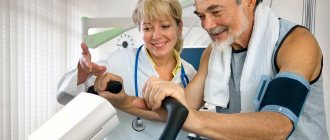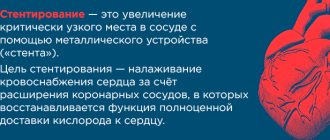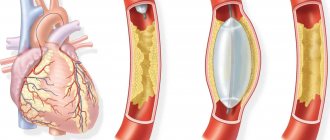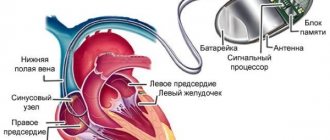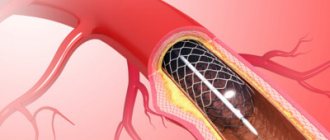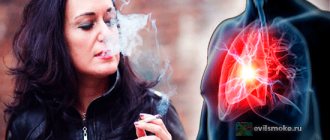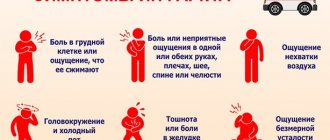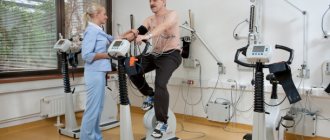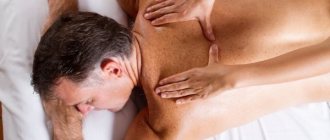Life after a heart attack is a new stage that completely changes a person’s habits. It is noticeably different from the previous way of life. And even under favorable circumstances, people who have had a heart attack remain at increased risk of sudden death.
How to arrange your life after a heart attack, what is possible and what is not during this period, read the article.
How is your lifestyle changing?
After a heart attack, the patient, often forced, completely reconsiders his life and the habits that led him to the disease:
- low mobility;
- alcohol, smoking;
- unhealthy diet;
- the presence of severe stress.
All these negative factors can quickly lead to relapse or more tragic consequences for health and life.
Therefore, it is important to make changes in all these areas to improve overall health and health of the body. Physical activity has a beneficial effect on overall well-being and the health of the heart and blood vessels. Muscles need sufficient load, but agreed upon with the attending physician.
Complete cessation of smoking and alcoholic beverages is an effective preventative method for possible heart problems. The compounds contained in cigarette smoke have a destructive effect on the arterial system and lead to vascular spasms.
A carefully selected diet, low in salts and fats of animal origin, takes significant stress off the entire cardiovascular system. Avoid fried foods and foods high in calories. Weight gain is an additional risk factor.
Situations that provoke anxiety, nervous tension, and worries must be eliminated from life as much as possible. Strong emotions, both joyful and not, lead to an increase in heart rate.
Myocardial infarction is a disease that has a direct effect on other systems and organs. Together with other pathologies that are present in many patients, such a diagnosis requires significant changes in life. This explains the importance of introducing new, healthy habits that will minimize the risks of a possible recurrence of a heart attack.
Stages of post-infarction rehabilitation
The effectiveness of restoring a person’s adaptive capabilities depends on the adequacy of the loads at different periods. In general cardiac rehabilitation there are three main stages:
- early;
- outpatient;
- remote.
The duration of the stages differs for each person depending on the clinical situation.
Early
The early period involves rehabilitation of the patient in a hospital setting in various departments.
- Intensive care and resuscitation department (no more than 3 days for uncomplicated cases). The patient is allowed to make body turns in bed, head movements and low-amplitude movements with the limbs. The exercise complex 1 is performed exclusively under the supervision of a therapeutic exercises instructor. The greatest attention is paid to the psychological side of recovery: conversations are held about the disease, the methods of treatment and rehabilitation used, and further modification of lifestyle.
- Cardiology department (10-14 days). The patient's motor mode expands to walking around the ward and riding a wheelchair along the corridor. A set of exercise therapy exercises 2 is used; if the patient’s reaction is positive, exits into the corridor are allowed.
- Inpatient stay at a specialized sanatorium or resort (up to 1.5-2 months). The main focus is the return of the patient to normal life, participation in an educational program for patients, and physical procedures.
Physical activity is severely limited due to the need to form an adequate scar at the site of necrotic myocardium, which will be able to maintain hemodynamic parameters at sufficient levels.
Outpatient
In foreign sources, the rehabilitation period after hospitalization is called the recovery phase. The average duration is 6-8 weeks, during which the patient is under the supervision of specialists from a clinic or outpatient center.
Main areas of work with patients:
- restoration of the patient’s physical capabilities;
- preparation for professional activity;
- secondary prevention of cardiovascular accidents and late complications.
During this period, the patient is offered to use rehabilitation methods in a clinic setting (physiotherapy, bicycle ergometry).
Remote (supportive)
The duration of this phase of patient rehabilitation implies lifelong adherence to the doctor’s recommendations regarding:
- physical activity;
- rational nutrition: such patients are recommended to follow a Mediterranean diet low in animal fats;
- giving up bad habits;
- adequate work activity (return to low-intensity work is possible 2 months after a heart attack).
In Russia, outpatient recovery involves regular visits to a local physician, as well as other doctors. In foreign countries, government programs provide a 21-day stay for patients in hospitals at specialized centers once a year.
How does health change after a heart attack?
After suffering from an illness, the quality of health changes both at the physical and mental levels. Much depends on age, general condition of the body, and the severity of the heart attack.
Systems and organs become at risk of developing various diseases, because the heart is no longer working at 100% and the delivery of oxygen and nutrients is inadequate. Relapse prevention measures are aimed at maximizing the restoration and maintenance of cardiovascular function.
Mental changes depend on the patient’s personality state and his reaction to a life-threatening disease. External factors (life environment) can have a significant impact on mental changes in health. These include influence:
- medical personnel;
- relatives and friends;
- roommates, etc.
It is necessary to create a favorable psychological climate around a person suffering from a heart attack. Especially in the first days and weeks, when there is a process of getting used to the new state and changing lifestyle.
The reaction to the disease in many people is adequate - they are interested in the necessary precautions, possible consequences, daily routine, nutrition, exercise, etc., follow the prescribed regimen and keep emotions under control.
Less often, patients experience fear of a possible recurrent heart attack and even death. They are timid about increasing physical activity. May be observed:
- restlessness in movements;
- increased heart rate;
- increased sweating;
- insomnia.
Elderly people complain about their own condition. They often overestimate the severity of the consequences of the disease and focus on health.
Many patients are faced with thoughts and fears of imminent death. If you do not change this thought process to a positive one, then depressed mood and depression will be ensured.
There are hysterical reactions that draw attention to one’s own person in order to evoke sympathy. Less often, a person does not accept his illness and completely ignores medical recommendations and does not comply with the regime. Without taking urgent measures, a second heart attack will not be long in coming.
In the absence of special help, changes in the psyche will intensify to the point of disability.
Characteristics of infarction
The severity, depth of the lesion and how extensive the infarction is must be determined at an early stage. This is done in the hospital when the patient is sent to the hospital; outpatient examination in the clinic is not possible at this stage. The timing of assistance and its volume play a big role.
If the heart lesion is diffuse, then a suspicion of transmural infarction arises. This is a severe pathology that may require bypass surgery. This diagnosis indicates a cessation of blood circulation not only on the surface of the heart wall, but in the deep layers of the heart or even affects the endocardium. This state of affairs poses a direct threat to the patient’s life; it is necessary to transport him to a cardiology center or hospital as soon as possible.
Prevention of recurrent heart attack
Such diseases always leave a mark on a person’s subsequent life. How to live after a myocardial infarction to prevent its recurrence?
The absence of repetitions is directly dependent on lifestyle and psychological climate. All changes and restrictions serve the sole purpose of maintaining health and preventing new attacks. After all, a relapse can be more extensive and serious. Basic rehabilitation measures after an illness include:
- feasible physical activity;
- prescribing and taking medications;
- lifestyle changes;
- creating a comfortable environment;
- return to feasible work;
- restoration of self-care ability.
It is a set of measures, as well as regular examination by a doctor and undergoing the necessary medical examinations, that reduces the risk of a second heart attack.
Are there any differences between stenting after a large heart attack and a small-focal one?
One of the indications for percutaneous balloon angioplasty is extensive heart attack. For such patients, this is a chance to limit the area of myocardial damage, prevent complications and recurrent attacks.
The surgical technique for any size lesion is not fundamentally different, but if a larger artery is blocked, thrombolysis (dissolution of a blood clot) can additionally be used.
It consists of introducing enzymes to dissolve the blood clot - Streptokinase, Urokinase. These drugs are effective only if no more than 12 hours have passed since the onset of the heart attack.
The success of the operation is determined by the degree of atherosclerotic changes in the arteries. In patients with a single lesion and the absence of calcification of the walls of the coronary vessels, it is higher, and less favorable results were obtained under the following conditions:
- several vessels are blocked;
- the arteries are long, convoluted, there are many lateral branches, which are also changed;
- There are calcium deposits in the arterial wall, and blood clots can be found in the lumen.
Stenting after a heart attack is indicated to limit the area of myocardial damage, prevent complications and relapse. The operation is performed using the endovascular method - a balloon is inserted through a catheter into the narrowing site to expand the lumen, then a stent is installed. This ensures the maintenance of vessel patency and the elimination of ischemia of the heart muscle.
We recommend reading the article about alcohol after a heart attack. From it you will learn whether you can drink alcohol after a heart attack and what is better - beer, wine or vodka. And here is more information about the diet after myocardial infarction.
After stenting, patients should follow recommendations for blood pressure control, increase physical activity to the desired level, adhere to a diet and take medications. This allows you to return to your previous work detail and improve your quality of life.
How to live after a heart attack?
After a heart attack, a person is able to live a happy and fulfilling life, but he will have to make an effort and find a balance between work and rest.
All measures are preventive in nature against possible complications.
Physically difficult and stressful work is contraindicated, because it leads to an increase in heart rate and stress on the rumen. Such people need to rest if any discomfort arises.
To prevent a repeat attack, it is necessary to agree with your doctor on the permissible load and diet. Nutrition should be changed and supplemented with foods that bring blood pressure and weight back to normal.
Simple walks in the fresh air are useful and have an invaluable effect on the body during the rehabilitation process:
- help compensate for the lack of physical activity;
- saturate the blood with oxygen;
- clear thoughts;
- change your depressed mood to a positive mood.
Regular examinations, examinations and tests will allow you to keep your health status under control and take timely measures in case of deviations. Stabilization of blood pressure, cholesterol and blood sugar levels indicate the correctness of the chosen rehabilitation measures.
The more attentive the patient is to rehabilitation, the faster he will be able to return to the fullest possible life.
Physical therapy exercises after stenting
After coronary stenting, it is very important to get used to living with scaffolds inside the vessels. The body must adapt to life in a new quality (especially after a myocardial infarction), and this requires loads. A very important point in the rehabilitation of the patient is physical therapy after stenting. Below is a set of exercises, the regular implementation of which will allow you to train the cardiovascular system after stenting surgery.
Gymnastics is carried out only with the blessing of the attending physician . The possibility of its implementation depends on the initial condition of the patient, his age and the disease that led to stenting. At first, the exercises are carried out while sitting, after a while, if you feel well, they do exercise therapy from a standing position. This complex is useful for all organs of the chest and back.
- I.p. standing (sitting). You need to raise your arms up from the sides - this is done while inhaling. Down - exhale. 5-7 times.
- I.p. similarly. Hands to shoulders, make circular movements in the shoulder joints. Do 5 times in each direction.
- I.p. similarly. Hands in the lock. Inhale towards your chest, exhale away from you. To the chest - inhale, behind the head - exhale. Repeat 4-5 times.
- I.p. standing (sitting). Take a light stick 110 cm: bamboo or plastic, or another light stick with a diameter of 3-4 cm. Place the stick vertically in front of you. We lean forward towards the stick - exhale. Repeat 4 times.
- I.p. similarly. A stick in your hands horizontally in front of your chest. Circular movements with a stick. 7 times in each direction.
- I.p. similarly. Hold the stick horizontally in front of you. We row the ends of the stick forward and backward 10 times.
- I.p. Same. The stick is held horizontally in front of you in your hands. Raise the stick up, lower it onto your shoulders by the back of your head - exhale. Raise the stick up until your arms are fully straightened - inhale, lower it down - exhale. Do it 7 times.
- I.p. standing (sitting). A stick behind your back in straightened arms. Hands with a stick up along the back - inhale, down - exhale. Repeat 8-10 times.
- I.p. Same. Stick behind your back with an overhand grip. We move the stick away from the back - inhale, tensing the muscles between the shoulder blades. Lower the stick - exhale. We do it 7 times.
- I.p. sitting on a stool or standing. A stick behind the back in the elbow bends. We twist horizontally to the right and left in the thoracic spine. Repeatedly.
- I.p. standing (sitting). We put the stick on our shoulders. We turn our heads to the right, to the left with straightening our arms along the stick in each direction 6 times.
- I.p. standing. The stick is located behind your back, grab the ends. Step to the right - right hand with the stick up, looking up at the end of the stick. We lower our hand and put our foot down. The same on the other side, 5 times in each direction.
- Belly breathing (extremely important for rehabilitation!) - 10 times. Inhale through your nose - inflate your stomach, exhale slowly through your mouth - deflate your stomach.
- I.p. standing, legs wide. The stick is vertical in front of you, resting on the floor. Leaning on the stick with one hand - inhale, the other slides down the stick - exhale. Also with the other hand. You need to do it 5 times.
According to the recommendations of the physiotherapy doctor at the Railway Hospital in Nizhny Novgorod
Changes in life
A heart attack conditionally splits a person’s existence into different periods. After it, you need to make drastic changes in your life in order to continue to be a member of society and feel normal.
A person needs to make the following metamorphoses in life after a heart attack:
- go to work only in a place where the conditions are comfortable and calm;
- take blood pressure medications and statins throughout life;
- perform physical exercises with mandatory heart rate monitoring;
- limit emotional background and excessive physical activity;
- eliminate alcohol and smoking;
- review your diet and give up some foods.
Such changes require the manifestation of strength of character, support from loved ones and material costs. The duration and quality of life will depend on the efforts of the patient himself.
Lifestyle and habits
How many lectures have been said, written, and given about the dangers of smoking, alcoholism and the use of stimulants for the cardiovascular system, but doctors again and again encounter patients who have undergone several months of recovery and have returned to their addiction.
It is worth recalling once again that after a heart attack you will have to give up smoking forever, as well as alcohol, energy drinks and other stimulants of the nervous system. This is extremely dangerous for the heart muscle and blood vessels. If you can’t do this on your own, then you need to seek the help of a psychologist who will help push these harmful habits into the background, and then completely eradicate them.
A prerequisite must be a proper diet, in which it is necessary to limit the amount of liquid. At the same time, you should drink enough water to help thin the blood to prevent blood clots.
Specialized control and psychological assistance
Patients after a heart attack must be registered at the dispensary and observed by a cardiologist. Periodically, they undergo preventive, medicinal courses of treatment to prevent relapses. They include drugs - antiplatelet agents that prevent blood clotting, heart medications, drugs that improve tissue nutrition, and vitamin complexes.
The help of a psychologist is needed at any stage of recovery after a heart attack. This is necessary so that the patient does not acquire fear of a heart attack in the future, leads an as active lifestyle as possible, can return to sexual activity and give up bad habits: smoking, alcohol. Often such support is necessary for those who are afraid to drive for fear of worsening their condition. The course of psychological assistance is free for post-infarction patients.
Physical exercise
After analyzing the patient’s condition, the cardiologist makes a number of prescriptions to maintain normal physical activity:
- physical therapy complex;
- anaerobic exercise;
- walking in the fresh air.
Lifting anything weighing more than three kilograms is prohibited.
Physical therapy classes are conducted under the supervision of a physical therapy doctor. He will promptly adjust the scheme and the permissible load based on the patient’s condition. An increase in load is also carried out by a doctor under the control of blood pressure, pulse and general well-being.
Indications for coronary stenting
Coronary aortocoronary stenting has a certain number of indications, but is performed only when all other methods of treating vascular pathology do not have the desired effect. Doctors identify the following main indications for stent placement:
- Ischemic myocardial damage against the background of stenosing atherosclerosis, in which atheromatous plaques block the lumen of the vessel by more than 50%.
- Acute, difficult-to-control attacks of angina pectoris that occur with minor physical exertion.
- Acute coronary syndrome with a high risk of progression to infarction.
- The first six hours during a heart attack when the patient’s general condition has stabilized.
- Repeated blockage or stenosis of an artery after angioplasty or another surgical procedure.
Despite a whole group of vital indications for this surgical intervention, there are a number of contraindications for which coronary stenting is not performed. These include:
- Lack of stabilization of the patient's condition - depression of consciousness, shock, variable pressure, the presence of renal, hepatic, or any other failure of one or more vital organs.
- Pronounced changes in the coagulogram are increased viscosity and blood clotting.
- Individual hypersensitivity reactions to iodine-containing contrast agents.
- The presence of multiple stenoses.
- Malignant neoplasms that cannot be treated.
- Damage to an artery with a lumen diameter of less than 3 mm.
Career
This cardiac pathology involves limiting stress of any nature. Rehabilitation therapy is carried out for four months, after which the issue of assigning a disability group is decided.
The medical and social examination, based on the instructions, makes a decision on establishing disability.
Assignment of a working disability group means that a person can carry out work activities, but under conditions that comply with the principles of rehabilitation of this category of patients.
If the job description involves physical activity or emotional stress, then a transfer to lighter work will be required, because Such working conditions negate previously conducted rehabilitation therapy and worsen health status.
Labor factors that are a contraindication for a heart attack:
- pressure and altitude changes (installers, stewards, pilots);
- emotional stress (teacher, salesperson, security guard);
- hazardous production;
- increased concentration of attention (driver, operating surgeon);
- night shifts;
- high danger and risk (firefighters);
- exercise stress;
- long walking distances (postman, guide).
After a heart attack, it is unacceptable to send a person to work away from medical care (logging, field work). A relapse is possible at any time, which occurs in a more dangerous and severe form than the first time.
Necessary control during physical activity
A test for the possibility of physical activity intensity is subsequently carried out on an exercise bike or treadmill.
As a rule, such exercises are recommended after 6 weeks of the recovery period after myocardial infarction. Next, exercises with tension of large muscles are included in the work. They are performed 3-4 times a week together with warm-up exercises for 20-30 minutes. With normal load tolerance and positive dynamics, it is recommended to increase the time of exercise by 5 minutes and repeat it up to 6 times a week. The introduction of swimming rehabilitation exercises into the group is possible as a secondary physical training, since swimming involves high energy costs for a heart that has not yet strengthened after a heart attack. After 2 months, the doctor is obliged to again check the patient’s heart response to therapeutic exercises and outline the next stage of training or, if necessary, stop it.
General recommendations for rehabilitation exercises in the post-infarction period should be taken into account by all patients. To avoid additional stress on the heart muscle, physical exercise and any other work should not be carried out after meals, in the heat in the open sun, in the cold, or in an upside down position. The training must be stopped if the patient feels the slightest malaise, chest pain, or intense heartbeat.
By following all medical prescriptions, regulating exercise and maintaining a healthy lifestyle in the future, you can avoid another heart attack recurrence. Monitoring by the attending physician will help identify all possible violations in rehabilitation and adjust treatment.
Lifestyle recommendations
Is it possible to install mustard plasters?
The need to use mustard plasters after a heart attack is best discussed with your doctor. There is a limitation in their use - they cannot be placed in the heart area.
Is it possible to fly on an airplane after a heart attack?
The pathology suffered makes many wonder whether it is possible to fly on an airplane after a heart attack or stenting. After completing the rehabilitation course, when the heart muscle begins to work within normal limits, it is allowed to fly. If there are no other restrictions. It is better to coordinate the flight with your doctor, undergo the necessary examination and receive recommendations to alleviate possible unpleasant moments associated with changes in pressure and altitude.
Flights are prohibited with diagnosed concomitant diseases:
- heart failure that cannot be corrected with medication;
- arterial hypertension or arrhythmia;
- unstable angina.
When you decide to fly by plane, you need to prepare for the flight:
- Place medications recommended by your doctor in your hand luggage.
- If anxiety occurs, take a valerian or corvalol tablet.
- Before takeoff, place a Validol tablet under your tongue. It will improve blood circulation and help relieve ear congestion when climbing.
- During the flight, you need to ensure yourself a pleasant pastime - listen to a concert of pleasant music, read or sleep.
- During the flight, you need to get up and walk around the cabin to restore blood circulation.
Is it possible to go to the sea?
When planning a trip to the sea, a number of restrictions must be taken into account:
- swim close to the shore;
- refuse diving;
- limit exposure to direct sunlight as much as possible, do not sunbathe;
- exclude heat.
Is it possible to drive a car?
One of the most common male professions is driver. And a man who has suffered an attack will wonder whether he can work as a driver after a heart attack and when he can even get behind the wheel.
Driving a car can lead to anxiety and anxiety. And this will adversely affect the condition. Therefore, doctors do not recommend such people to take responsibility and drive a vehicle, because a relapse can occur at any time.
Is it possible to take a steam bath?
High temperatures put a lot of stress on the heart. Therefore, it is prohibited to take a steam bath before the scarring period has ended. Only the attending physician, with constant observation, can give an answer as to when you can go to the bathhouse after a heart attack.
Sudden changes in temperature are prohibited - diving into a pool, ice hole or snowdrift. Instead, air baths or showers at room temperature are indicated.
Some statistics
Statistics say that today the rapid mortality of patients after myocardial infarction is only 12% of the total number of patients with a similar diagnosis.
A heart attack is not a death sentence. Those who have suffered this disease often become depressed, believing that they will have to deal with the consequences of this disease for a long time, and maybe until the end of their days. They begin to think that they will not be able to do their favorite activities and will have to watch life from the outside. But if you believe the statistics, this is absolutely not the case.
Even before the beginning of the last century, it was believed that this disease occurs in older people. And it was much less common than it is now. Now myocardial infarction occurs in fairly young people aged 30-35 years. And if earlier this was more common in men, now this disease is often registered in women.
Currently, there are many cases where survivors of myocardial infarction return to a full life, live a long time and at the same time feel quite happy. But this is only possible if certain rules are followed. Even the slightest relaxation increases the risk of a second heart attack and unpredictable consequences.
My family was not spared from this problem, although for my husband everything turned out more or less well. But how he can live after suffering a myocardial infarction has now become a pressing topic for me. I had to rummage through my notes and on the Internet, remembering moments from practice. The information may also be useful to someone, so I decided to share it here on the blog. I will describe only the main points that you need to adhere to while already at home.
Is it possible to play sports after a myocardial infarction?
It is possible and necessary. But careful dosing and individual selection of the sport are required.
What kind of sport is useful?
All types of aerobic sports are suitable, in which it is necessary to move the limbs, observing the rhythm. Walking and swimming are the most preferred. If you feel stable, you are allowed to ride a bicycle.
What sport is not recommended?
Doctors prohibit running. With it, a hormonal surge occurs, incl. adrenaline, and it has a negative effect.
Strength training, exercise in the gym, lifting barbells and weights are contraindicated. Such exercises can lead to increased blood pressure.
How to organize a training session?
The purpose of physical activity is to improve the general condition of the patient. To achieve this, you need to follow some rules:
- monitor the pulse, it should not exceed 120 beats per minute;
do not train in the cold or in direct sunlight;- do not sharply increase the load;
- exclude exercises in the “upside down” position;
- If you feel dizzy, stop training;
- start training no earlier than two hours after eating.
Life-saving stenting after a heart attack: installation features, limitations after
To restore the patency of the coronary artery, a metal frame (stent) is installed, which prevents the walls from compressing. This operation is called stenting and is performed using a catheter with a balloon at the end. Prescribed for the treatment of ischemic disease, including in the post-infarction period. After stenting, patients are prescribed cardiac rehabilitation.
Why is stenting performed after a heart attack?
The main cause of myocardial infarction is blockage of the coronary arteries of the heart by cholesterol plaques. They cause ischemic processes in the heart muscle and attacks of pain.
A severe attack of angina can develop into a heart attack.
If it is possible to restore arterial patency in the first hours, this significantly reduces the area of destruction of the muscular layer of the heart and helps restore normal cell function.
If an acute disturbance of coronary blood flow nevertheless leads to necrotic changes in the myocardium, then stenting in the post-infarction period helps solve the following problems:
- avoid recurrent attacks;
- prevent complications such as arrhythmias and heart failure;
- improve exercise tolerance;
- restore ability to work;
- improve the quality of life of patients;
- avoid long-term and massive drug therapy.
Stent
The stenting method has many advantages: no open access to the chest is required, which reduces the risk of complications and infections, the operation itself lasts up to 2-3 hours, and the recovery period usually does not exceed a month. After stenting, there are no strict restrictions on physical activity and work activity after rehabilitation.
We recommend reading the article about coffee after a heart attack. From it you will learn about the effects of coffee on the body and whether heart patients can drink the drink.
And here is more information about exercise therapy after a heart attack.
Angioplasty
The stent is a mesh tube made of cobalt. Recently, they have been coated with a special compound that prevents the fixation of blood clots. The coating allows you to keep the vessel lumen open longer and eliminates the need for repeated surgery to recanalize the artery.
Surgical intervention is performed as follows:
- The femoral artery is punctured (a small incision is made).
- A catheter with a balloon at the end is passed through it.
- Under X-ray control, the catheter is advanced to the site of blockage.
- Fill the canister with air, pressing the plaque against the walls.
- When the balloon expands, the stent expands and is fixed in the artery.
- After installation, the catheter is removed.
A pressure bandage is applied to the puncture site , and the patient is transferred to the ward. Monitoring of heart function is carried out by monitoring blood pressure, pulse rate and ECG readings. Drug therapy is prescribed.
Possible complications after
The risk of postoperative cardiac dysfunction is quite low, but in the presence of blood clotting pathologies, diabetes mellitus or kidney disease, the following consequences are possible:
- restenosis - the artery is repeatedly blocked due to the formation of a blood clot, spasm, detachment or tear of the inner layer;
- bleeding, thrombosis or hematoma in the femoral artery;
- blockage of the coronary arteries by detached clots (heart attack in a new zone);
- heart failure;
- kidney dysfunction.
Treatment of a patient after vascular stenting, heart attack
If, after a follow-up examination, the patient has no cardiac abnormalities or signs of complications, then after 2–5 days he is discharged for outpatient treatment. Complex therapy is prescribed to thin the blood and restore microcirculation in the myocardium. To improve long-term results of stenting, the following groups of agents are used:
| Aspirin, Plavix or Brilinta | |
| Reducing blood cholesterol levels | Zokor, Atoris, Crestor, Traikor |
| Renin-angiotensin-aldosterone system locators | Diroton, Prestarium, Hartil |
In order to influence the main symptoms of ischemic disease, the following is prescribed:
| Isoptin, Diacordin, Norvasc, Adalat |
| Coraxan, Sidnopharm, Cordinic, Ranexa, Preductal |
Medication therapy is carried out for at least three months, after which an examination is indicated, which includes an ECG and stress tests to identify signs of restenosis and determine tolerance to physical activity. Based on the diagnostic results, adjustments are made to the treatment plan.
Life, rehabilitation and recovery after
The need for lifestyle changes, mandatory abandonment of bad habits, dosed physical activity and diet is due to the fact that with stenting it is possible to remove not the cause of myocardial ischemia, but also its consequences. At the same time, the coronary arteries remain altered by atherosclerosis, therefore, to prevent recurrent heart attacks, patients are shown a complex of rehabilitation measures.
Do they give disability
The operation itself to restore the patency of the coronary artery during angioplasty with stenting is not a reason for loss of ability to work and assignment of a disability group. In most cases, lost performance is restored and the patient can return to his professional activities.
The timing of complete rehabilitation varies. They depend on the patient’s condition and the type of load. There are professional restrictions - types of activities that are contraindicated after stent implantation:
- pilots;
- drivers;
- high-altitude work;
- with night shifts;
- industrial enterprises with harmful working conditions (hot shop, vibration, chemical compounds).
If the patient belongs to this category, then he is temporarily limited in his ability to work with a recommendation to change jobs.
The patient's blood pressure
High arterial hypertension creates hemodynamic conditions for increased stress on the heart muscle and accelerates the formation of blood clots. Therefore, for more durable operation of the stent, it is recommended to maintain blood pressure no higher than 140/90 mmHg. Art.
If the patient has concomitant kidney disease or diabetes mellitus, then the upper acceptable limit is 10 units lower for each indicator. It is necessary to monitor the pressure level daily in the morning and before bedtime; if there are frequent fluctuations, it is recommended to monitor the indicators at least once a week and keep a diary of your well-being.
Permissible load
Stenting is considered successful only if the patient's exercise tolerance improves. To expand the body's capabilities, training the heart muscle is mandatory. Regular dosed activity inhibits the progression of disorders of fat and carbohydrate metabolism, improves resistance to oxygen starvation and helps maintain normal weight.
In the first stages, all patients are prescribed physical therapy, breathing exercises and walking . The specific level of stress is determined by the doctor based on the results of the examination. After the condition has stabilized, you can go swimming, cycling, or light jogging. Heavy lifting and sports that could cause a blow to the heart are strictly prohibited.
Diet food
To normalize cholesterol levels in the blood and prevent further blockage of the arteries, it is necessary to reduce the absorption of animal fats and simple carbohydrates into the body. To do this, exclude from the diet:
- lamb, pork, duck, lard, offal;
- fatty sausages, semi-finished products;
- margarine, mayonnaise;
- pastries, white bread;
- confectionery, sweets, sugar;
- sweet juices and carbonated drinks, industrial sauces;
- canned food;
- alcoholic drinks.
Used in limited quantities:
- butter (no more than 5 g per day);
- sour cream;
- heavy cream;
- curd desserts;
- eggs (3 pieces per week);
- salt (no more than 3 g to add to prepared dishes);
- coffee, strong tea.
First courses should be prepared vegetarian . After stabilizing the cholesterol content - in vegetable broth with fish or chicken meatballs, infusions are not recommended for patients with myocardial ischemia.
For main courses, you can use lean meats (chicken, turkey) and fish . The preferred types of cooking are steaming, boiling in water, and baking.
They can be served as a side dish with whole grain porridge (oatmeal and buckwheat), boiled or steamed vegetables. Be sure to include a salad of fresh vegetables with vegetable oil in your main meal. For dessert, fruit compotes, mousses and jellies are prepared.
Dried fruits, berries and nuts are healthy.
Maintenance medications
An important part of the myocardial recovery process is drug therapy. It is continued even after the elimination of the main manifestations of the disease. Although stenting can significantly reduce the need for medications, some drugs must be taken for a long time to prevent thrombosis and normal metabolism in the heart muscle.
The most optimal combination of drugs to reduce blood clotting is acetylsalicylic acid and Clopidogrel. These medications prevent blockage of the installed stent and significantly reduce the risk of another heart attack.
Aspirin can irritate the gastric mucosa, so special cardiological forms with a reduced dosage are recommended, the tablets of which are coated with an acid-resistant coating - Thrombo Ass, Lospirin, Cardiomagnyl.
Are there any differences between stenting after a large heart attack and a small-focal one?
One of the indications for percutaneous balloon angioplasty is extensive heart attack. For such patients, this is a chance to limit the area of myocardial damage, prevent complications and recurrent attacks.
The surgical technique for any size lesion is not fundamentally different, but if a larger artery is blocked, thrombolysis (dissolution of a blood clot) can additionally be used.
It consists of introducing enzymes to dissolve the blood clot - Streptokinase, Urokinase. These drugs are effective only if no more than 12 hours have passed since the onset of the heart attack.
The success of the operation is determined by the degree of atherosclerotic changes in the arteries. In patients with a single lesion and the absence of calcification of the walls of the coronary vessels, it is higher, and less favorable results were obtained under the following conditions:
- several vessels are blocked;
- the arteries are long, convoluted, there are many lateral branches, which are also changed;
- There are calcium deposits in the arterial wall, and blood clots can be found in the lumen.
Stenting after a heart attack is indicated to limit the area of myocardial damage, prevent complications and relapse. The operation is performed using the endovascular method - a balloon is inserted through a catheter into the narrowing site to expand the lumen, then a stent is installed. This ensures the maintenance of vessel patency and the elimination of ischemia of the heart muscle.
We recommend reading the article about alcohol after a heart attack. From it you will learn whether you can drink alcohol after a heart attack and what is better - beer, wine or vodka.
And here is more information about the diet after myocardial infarction.
After stenting, patients should follow recommendations for blood pressure control, increase physical activity to the desired level, adhere to a diet and take medications. This allows you to return to your previous work detail and improve your quality of life.
Watch the video about stenting after myocardial infarction:
Source: https://CardioBook.ru/stentirovanie-posle-infarkta/
Rehabilitation highlights
Rehabilitation measures include the following areas where attention should be directed:
- diet;
- eliminating bad habits;
- pressure control;
- dosed physical activity;
- psychological rehabilitation;
- return to intimate life.
All of them are important in a person's life. They begin to be carried out already in the hospital, trying to quickly restore skills lost due to illness. The rehabilitation program is individual in nature and its duration and content are formed based on the capabilities and abilities of the patient.
Weight control and dieting
The main goal of the prescribed diet is to normalize weight and regulate blood cholesterol levels.
The following products are excluded:
- pork;
- fatty meats;
- milk;
- legumes;
- fish and meat broths;
- white flour products;
- smoked meats;
- marinades.
It is necessary to shift the balance of foods in the diet towards vegetables, lean meats, fish, and vegetable fats. Processing of products should be done by steaming, baking or boiling.
Diet recommendations after a heart attack:
- reducing the calorie content of dishes;
- exclusion of culinary products - cakes, sweets, pastries;
- minimizing animal fats;
- refusal of spices, sauces;
- avoiding salt or reducing it to a minimum;
- eating up to five times a day in small portions;
- a shift in the carbohydrate component of the diet towards protein and fiber.
Drinks such as kvass and coffee should be avoided. They serve as a source of excess fluid in the body and increase blood pressure.
Include lean meat, nuts, flax seeds, olive oil, vegetables, fruits, fish oil, lettuce, and garlic in your diet.
Treatment of a patient after vascular stenting, heart attack
If, after a follow-up examination, the patient has no cardiac abnormalities or signs of complications, then after 2–5 days he is discharged for outpatient treatment. Complex therapy is prescribed to thin the blood and restore microcirculation in the myocardium. To improve long-term results of stenting, the following groups of agents are used:
| Fund groups | Drug names |
| Antiplatelet agents | Aspirin, Plavix or Brilinta |
| Reducing blood cholesterol levels | Zokor, Atoris, Crestor, Traikor |
| Renin-angiotensin-aldosterone system locators | Diroton, Prestarium, Hartil |
In order to influence the main symptoms of ischemic disease, the following is prescribed:
| Fund groups | Drug names |
| Beta blockers | Betalok, Concor, Nebilet |
| Nitrates | Cardiket, Olycard retard |
| Calcium antagonists | Isoptin, Diacordin, Norvasc, Adalat |
| Funds from different groups | Coraxan, Sidnopharm, Cordinic, Ranexa, Preductal |
Medication therapy is carried out for at least three months, after which an examination is indicated, which includes an ECG and stress tests to identify signs of restenosis and determine tolerance to physical activity. Based on the diagnostic results, adjustments are made to the treatment plan.
Rejection of bad habits
The question of whether it is possible to smoke after a heart attack should be clearly explained by the patient’s attending physician.
Bad habits serve as a provoking factor in the occurrence of a pathology such as a heart attack. Quitting smoking and drinking alcohol, incl. beer, have a beneficial effect on the body and help to successfully complete the recovery course, and also reduce the risk of relapse in the future.
If you really want to remember the taste of a foamy drink, you can sometimes drink a non-alcoholic one.
Cost of heart stenting
As with any other surgical intervention, there is no one specific price for stenting. The cost depends on many components - the patient’s condition, the type of stent, the urgency of the operation, individual characteristics, etc.
On average, the price of a planned operation in Russia is about 100–150 thousand rubles. In Ukraine, the average price range is in the range of 30–40 thousand UAH. In Israeli clinics the cost starts from 13 thousand dollars (SYFFER stent).
Physical activity and therapeutic exercise
Physical activity recommended by your doctor is acceptable. This is physical therapy based on special exercises. They are carried out under the supervision of a physical therapy doctor. It measures heart rate and regulates the load. An individual intensity is set for each patient.
People after a heart attack can do the following normal activities:
- swimming;
- walking;
- a ride on the bicycle.
The main thing is the absence of jerks and uniform movement.
Inadequate load, not agreed with the doctor, can lead to serious complications.
For older people, it is enough to take quiet, accompanied walks in the fresh air.
Aspects of the disease
An acute disturbance or cessation of the blood circulation process in a certain area of an organ or muscle is a heart attack. Sudden bleeding leads to dysfunction of the organ. If help does not arrive on time or is insufficient, then permanent loss of the usual volumes of functions performed or disability is possible. As for cardiac infarctions, the prognosis, the course of the post-infarction period, as well as recovery depend on many circumstances:
- characteristics of the cardiovascular system;
- state of the patient's nervous system;
- presence of concomitant diseases and complications;
- age;
- floor;
- characteristics of infarction;
- accessibility and completeness of treatment measures.
A prosperous early post-infarction period is a very important condition for life after a heart attack to be full and long and rich. To put the patient back on his feet, to restore health - to achieve this goal, you must strictly follow the doctor’s recommendations; you cannot self-medicate. For all patients without exception who have had a heart attack, regardless of age or gender, the following recommendations are mandatory:
- observe bed rest, the duration of which is at least 7-10 days;
- sitting up in bed and turning over on your left side is only possible with the permission of a doctor;
- after a week or two, you can get up near the bed;
- by the end of the third week, you are allowed to walk no more than half an hour per day.
Each stage is carried out under the supervision of a doctor or strict nursing supervision is assigned. The pulse rate must be monitored and blood pressure measured. These indicators characterize the state of the body, readiness for recovery, and the possibility of increasing physical activity.
Psychological help
Almost all patients who have had a heart attack require psychological assistance. Common violations are:
- fear of loneliness;
- sleep problems;
- emotional instability;
- fear of cardiac arrest;
- formation of an inferiority complex;
- irritability.
Such deviations lead to the formation of neurosis and chronic hypochondria. Such conditions have a negative impact on the physical health of the body, leading to a drop in blood pressure and poor quality rest, which is fraught with complications for the heart.
The help of a psychologist is recommended so as not to worsen your general health.
Intimate life
Sex is of great importance in returning to a full life, for both men and women. But it additionally loads the cardiovascular system and changes the overall emotional background. Therefore, it is necessary to return to it smoothly, and following the recommendations:
after discharge from the hospital, you should abstain from sex for 30 days;- provide a calm environment and minimal stress;
- avoid drinking tea, coffee, food before and after contact;
- Don't have sex at the expense of sleep.
Males may experience problems with erection, which can be solved by selecting stimulants. Consultation with a cardiologist in this case is mandatory, because many of them can cause your heart rate to increase.
Nutrition after a heart attack
Men who have undergone heart surgery due to a heart attack should understand that upon discharge from the hospital it is important to maintain the rules established by the doctor. A healthy lifestyle and diet should become a healthy habit and the norm.
To maintain your body and stay healthy, you need to follow a few simple rules:
- the majority of the diet should be carbohydrates (60%), half as much protein (30%) and a minimum of fat (10%);
- avoid fatty and spicy foods;
- do not get carried away with pickles and marinades;
- fill your diet with seafood and dried fruits;
- train yourself to eat vegetable and lean soups, drink natural, freshly squeezed juices;
- you need to eat at least four times a day;
- Under no circumstances should you overeat at night.
A proper diet, moderate exercise and medications together will help you maintain your health for many years.
